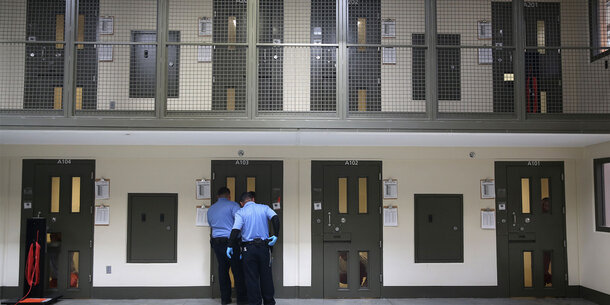On the campaign trail, Joe Biden vowed to end the federal government’s use of private prisons, declaring that “the federal government should not use private facilities for any detention, including detention of undocumented immigrants.” His policy platform also stated that his administration would tie funding decisions for a new grant program to the elimination of private prisons and all forms of for-profit incarceration.
Given these promises, it wasn’t surprising when Biden issued an executive order in January directing the attorney general not to renew Justice Department contracts with privately operated criminal detention facilities.
In substance, the order mostly replicated a similar Obama-era policy that allowed private prison contracts between firms and the federal Bureau of Prisons to expire without renewal, although Biden’s order goes slightly further by also applying to U.S. Marshals Service (USMS) contracts.
The executive order is an initial step for cutting ties with for-profit firms that earn revenue from prison contracts, and there are additional things that the administration could do to further disentangle profit from detention. For example, this order does not affect facilities these firms manage on behalf of U.S. Immigration and Customs Enforcement. Also, firms have started to circumvent the order by engaging in intergovernmental service agreements with counties that then contract directly with the federal government for immigration or marshals’ detention services.
The opposition to private prisons
Firms that own and manage jails, prisons, and immigrant detention facilities have long come under scrutiny since the industry emerged in the mid-1990s. As I’ve written before, it has been criticized since it has existed.
Some argue the profit motive creates perverse incentives that drive overcrowding by cutting costs and reducing the quality of life for those who are incarcerated or detained. Or that the corporations that manage these facilities earn additional revenue when individuals in their custody stay incarcerated for longer periods of time, encouraging staff to hand out extra infractions that result in longer stays. Others take issue with the concept of a corporation profiting off the nation’s penchant for incarceration. And for decades, some legal scholars and policymakers contended that there are certain state functions that simply cannot be delegated — and that one of those is punishment.
Despite years of growth for this industry, in 2019, Wall Street banks began to distance themselves from financing them, especially as these firms that manage and own prisons and immigration detention centers received negative attention amidst an outcry over the Trump administration’s detention policies.
Will contracts to manage ICE facilities be renewed?
As noted above, the executive order does not affect ICE contracts because ICE is part of the Department of Homeland Security, not DOJ. While undocumented individuals housed in ICE detention peaked at more than 55,000 people under President Trump and significantly dropped during the pandemic, that number is creeping back up. More than 25,000 people are currently held in ICE detention as of early August, and about 80 percent of ICE detention beds are still owned or managed by for-profit firms.
ICE contracts made up 28 percent of 2020 revenue for both GEO Group and CoreCivic, two of the biggest private prison companies. So far, the Biden administration has not made a move to eliminate ICE contracts with for-profit firms. Under the Obama administration, then-DHS Secretary Jeh Johnson formed a DHS Advisory Council to review the department’s policies and practices related to private immigration detention and “evaluate whether this practice should be eliminated.”
The council ultimately recommended that ICE expand measures to provide more robust oversight of private facilities, but by the time the council issued its recommendations, Trump had been elected and President Obama had little time left to implement these changes.
It’s possible that the administration will also seek to reduce ICE’s reliance on private detention and improve oversight of those facilities, but there’s been little hint from the administration as to whether they will focus on ICE contracts with for-profit firms.
Initial effects
Biden’s executive order has started to have an impact on GEO Group and CoreCivic, which both have a considerable number of federal contracts to manage prisons and immigration detention centers. Yet the executive order applies to contracts as they come up for renewal, making it difficult to calculate the full impact on this industry a mere seven months later.
But here’s what we know so far: In May, GEO Group’s contract with BOP to manage the Great Plains Correctional Facility located in Hinton, Oklahoma, expired. The prison — which housed more than 1,500 people — was the largest employer in the area, and Oklahoma’s two senators urged Biden to reverse his order due to the potential negative economic impact of the closure. A GEO Group representative told officials in Hinton that it would look for new contracts with other government agencies in an attempt to hold prisoners there in the future.
GEO Group noted it expects two additional BOP correctional facilities to close before the end of the year (Big Spring and Flight Line facilities in Texas) as a result of the executive order. CoreCivic indicated it has four contracts with USMS set to expire in 2021, likely without renewal, in addition to only one contract with the BOP.
Increased use of intergovernmental service agreements
Additionally, the executive order may unintentionally create a scenario where for-profit firms sign more contracts with counties that then directly contract with the federal government, allowing the firms to essentially circumvent the order. In fact, GEO Group seems to interpret the executive order as one that “appears to be focused on direct contracts with private sector service providers.”
And as GEO Group recently noted during an investor call, when it comes to its contracts with USMS, it operates three facilities under direct contracts and nine facilities that are part of inter-governmental agreements, meaning Geo Group’s contract could technically be with a county or state government, not DOJ. In fact, three months after the executive order, CoreCivic signed a new 3-year contract with Mahoning County, Ohio for 990 beds at their Northeast Ohio Correctional Center. According to CoreCivic, the contract “served as a replacement to the previous direct contract with the United States Marshals Service for up to 992 beds to house federal detainees.”
Need to shrink overall carceral footprint
While the DOJ order appears narrowly tailored to removing the private financial stakes in federal incarceration, it’s important to note that the order may not result in shrinking the overall carceral footprint. For example, the population in some impacted facilities is simply being shifted to government-managed facilities.
There is already at least one convoluted situation where a state signed a contract to house its own custodial population in a newly vacant private facility that was forced to empty out due to the executive order. In Montana, the DOJ order set in motion a complicated swap of custodial populations between county, state, and federal agencies in addition to CoreCivic. Detainees housed by USMS at the CoreCivic-owned and operated Crossroads Correctional Center were moved to the Great Falls Regional Prison (GFRP), where some Montana Department of Corrections (MDOC) prisoners were recently housed. MDOC negotiated a contract with CoreCivic to transfer some of those in their state prison population, who had been housed at the GFRP under a contract with Cascade County for 152 beds, to CoreCivic’s Crossroads Correctional Center (which previously held the federal detainees). This reshuffling produced a game of musical chairs between facilities and who manages certain custodial populations.
There are other situations that don’t include such complicated swaps, where DOJ has succeeded in eliminating contracts with for-profit firms. However, the individuals housed in some of these private prisons were merely transferred to other facilities (yet government-managed), so custodial populations were not actually reduced. For example, the approximately 1,640 people who were housed at the Geo Group managed Moshannon Valley Correctional Center in Pennsylvania were sent to government-run BOP facilities for the rest of their sentences. Additionally, USMS did not renew its contract for GEO Group’s 222 bed Detention Facility in New York City that ended in March. These mostly pretrial defendants, many of whom are cooperating witnesses, were transferred to other government-managed facilities.
The federal prison population
As of August 26, the BOP reported 155,730 people in its custody, with 9 percent of them in privately managed facilities. If you compare this number to year-end federal prison populations, this is the lowest federal prison population since 2000. However, as law professor Doug Berman pointed out, the day after Biden’s inauguration, the BOP population clocked in at 151,646, and that number has been rising ever since.
During an investor call in May, CoreCivic’s CEO acknowledged, “BOP has experienced a significant decline in inmate population since 2013 and simply does not have as much of a need for prison capacity for the private sector.” Although the federal prison population dropped during the pandemic, the privately managed prison firms are surely keeping a close eye on the increasing numbers.
One major strategy to reduce the private prison footprint is a matter of supply and demand. Reducing federal custodial populations needs to be part of the solution. It would be more impactful if the Biden administration focused on how to reduce the number of people in our federal and state prisons, local jails, and ICE detention facilities.
This requires a multi-faceted approach of better utilizing federal grant money to incentivize states to reduce their carceral footprint, working with Congress to change sentencing laws, commuting the sentences of the more than 4,000 people who have been successfully placed on home confinement under the expanded CARES Act authority, and reimagining our immigration detention policies. This is necessary work to shrink the size and scope of our immigration and criminal legal systems.






